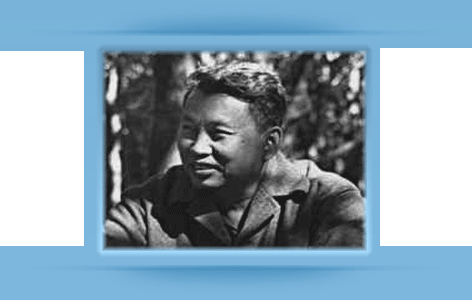Khmer Rouge, Communist movement that ruled Cambodia from 1975 to 1979. The regime, which was headed by Cambodian guerrilla commander Pol Pot, came to power after years of guerrilla warfare... |

Pol Pot is a pseudonym for the Cambodian guerrilla commander Saloth Sar, who organized the Communist guerrilla force known as the Khmer Rouge. The Khmer Rouge ousted General Lon Nol in 1975, establishing a Communist regime in Cambodia. As prime minister, Pol Pot ruled harshly, forcing most of the urban population out of the cities to farm in the countryside. Pol Pot's regime was responsible for the deaths of close to 1.7 million Cambodians before being overthrown by invading
Vietnamese in 1979.
Pol Pot (1925-1998), Cambodian political leader, whose radical Khmer Rouge movement controlled the government of Cambodia from 1975 to 1979. Under Pol Pot’s totalitarian regime, about 1.7 million Cambodians were killed and Cambodia fell into economic ruin.
Pol Pot was born Saloth Sar in Kompong Thom Province. At that time Cambodia was a Buddhist kingdom under French control. His parents had royal connections: his cousin was one of King Sisovath Monivong’s wives, his sister was a consort, and his brother Loth Suong made a career in the palace. Sar had a strict, sheltered childhood. In 1934 he joined his brother at the palace compound in Phnom Penh, Cambodia’s capital, and spent a year in a royal monastery followed by six years in an elite Catholic school.
In 1948 Sar went to study radio electricity in Paris, where he joined the French Communist Party. He kept company with Khieu Ponnary, the first Khmer (ethnic Cambodian) woman to receive a bachelor’s degree, and they were married in 1956. Sar’s student friends included Khieu Samphan, Ieng Sary, and Son Sen. Each person in the group adopted a pseudonym. Sar chose “Khmaer Da’em,” meaning “Original Cambodian,” while the others chose more modern code names such as “Free Khmer” and “Khmer Worker.” Later, in the mid-1970s, Sar adopted the pseudonym he is most widely known by: Pol Pot (which has no particular meaning).
Pol Pot failed his courses in Paris and returned to Cambodia in 1953. A movement for independence from France had been gaining strength since the end of World War II (1939-1945), and Pol Pot joined the Cambodian and Vietnamese Communists who were fighting the French in a common cause. The Vietnamese taught Pol Pot how to organize peasants for resistance, but he felt that this assignment was a patronizing slight for someone raised in the palace. His resentment of the Vietnamese was exacerbated when they failed to quickly promote him to a leadership position despite his overseas experience.
France granted Cambodia independence in 1953, and the government of King Norodom Sihanouk was recognized as the country’s sole legitimate authority at the Geneva Conference the next year. Pol Pot and other radicals who had fought the French alongside Vietnamese Communists went underground. Pol Pot moved to Phnom Penh and resumed working to establish a Communist government in Cambodia. Pol Pot rose in the ranks of the Workers Party of Kâmpŭchéa (later renamed the Communist Party of Kâmpŭchéa, or CPK). In February 1963 he became the CPK’s secretary general, or top leader, after his predecessor, a former Buddhist monk, mysteriously disappeared.
In July 1963 Pol Pot left Phnom Penh to establish a rebel base in the mountains of northeastern Cambodia. Under his leadership, the CPK began to wage guerrilla attacks against the government in 1967. It was during this time that the Khmer Rouge—the name given to CPK members by Sihanouk—emerged as a major force. Once rural, Buddhist, moderate, and pro-Vietnamese, the Communist leadership became became urban, French-educated, radical, and anti-Vietnamese under Pol Pot’s influence.
After eight years of guerrilla warfare, Pol Pot’s Khmer Rouge movement took over the Cambodian government in 1975. Declaring the state of Democratic Kâmpŭchéa (DK), Pol Pot cut Cambodia off from the world. He banned foreign and minority languages and attacked the neighboring countries of Laos, Vietnam, and Thailand in an attempt to regain ancient “lost territory.” Seeking to restore the “purity” of the Khmer race (the ethnic majority in Cambodia), Pol Pot eliminated foreign-educated people (with the exception of his Paris group) and non-Khmers living in Cambodia, especially the Vietnamese. Despite food shortages, rice was exported to China along with rare wild animals in exchange for weapons. An atheist, Pol Pot suppressed Cambodia’s Buddhist religion: monks were defrocked; temples and artifacts, including statues of Buddha, were destroyed; and people praying or expressing other religious sentiments were often killed. In an effort to rebuild the powerful, agriculture-based economy of the medieval Ângkôr kingdom, the government emptied the cities through mass evacuations and sent people to the countryside. Cambodians were overworked and underfed on collective farms, often succumbing to disease or starvation as a result. Spouses were separated and family meals prohibited in order to steer loyalties toward the state instead of the family. About 1.7 million Cambodians, or about 20 percent of the population, were worked, starved, or beaten to death under Pol Pot’s regime.
The Vietnamese army overthrew Democratic Kâmpŭchéa on January 7, 1979, in retaliation for Khmer Rouge attacks on Vietnam. Pol Pot and the remnants of his forces fled to the Thai-Cambodian border and began a long campaign to retake power. In the late 1980s Pol Pot remarried and had a daughter with his second wife. In 1996 the Khmer Rouge army began to break up when Ieng Sary, Pol Pot’s brother-in-law and the former deputy prime minister of DK, defected to the Cambodian government. In 1997 Khmer Rouge leaders detained Pol Pot, staging a show trial and placing him under house arrest. Pol Pot died in April 1998; in May the Cambodian government claimed that its troops had captured the last of the Khmer Rouge’s positions along the Thai-Cambodian border.
|
